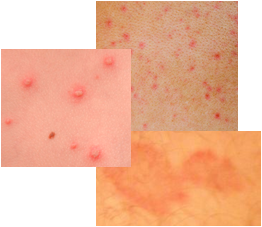Keratosis Pilaris - The Chicken Skin Rash
Visit this
PICTURES OF RASHES PAGE
Keratosis pilaris is perhaps the most well known of the keratosis skin conditions.
Symptoms of this Rash
Many people refer to this type of keratosis as chicken skin or chicken skin rash or goose flesh. The reason for this is because the skin that is affected by pilaris has the appearance of the skin on a chicken or like goose bumps. The bumps are small, flesh colored or white, and many of them are usually present. In some people, the small bumps may be red and inflamed. Often the bumps are described as acne-like or as having a sandpaper texture. They are painless and generally do not itch.
Keratosis polaris or pilaris usually affects the back of the upper arms, the thighs, and the buttocks regions. It can also appear on the face and can be misdiagnosed as an acne problem. It is more common in teenagers than any other age group, but infants and older individuals may also experience this type of keratosis. In fact, up to 50 percent of adults may experience this chicken skin problem in various degrees. When skin becomes dry, the pilaris condition becomes worse. Therefore, chicken skin is more prevalent in the winter months.
Chicken Skin Rash Causes
What causes this type of keratosis? This skin problem is the result of a build up of keratin, which subsequently blocks the hair follicles in the skin. The tendency for this to happen in not clearly understood, but it is hereditary. The blockage results in the formation of small bumps on the surface of the skin. Although the appearance is disliked by many it is considered a harmless skin problem.
Keratosis Pilaris Treatment
Keratosis polaris or pilaris does not need to be treated and it may disappear on its own after many years. If treatment is pursued, then there are several options as outlined below. However, it must be kept in mind that pilaris is difficult to treat and the treatments are not cures. In many cases, keratosis polaris returns despite the successful removal of the chicken skin with a treatment.
Soaking and Gentle Exfoliation
A simple treatment for this type of keratosis involves soaking in a hot tub and using gentle exfoliation of the problem skin areas with a washcloth or other suitable exfoliating device to help unclog the skin pores. The key is gentle exfoliation because if the rubbing is too aggressive, then there is the possibility of aggravating the skin condition.
Frequent Moisturization
A suitable moisturizer can be used on the affected skin. The moisturizer is used often and this may include application of the moisturizer several times a day.
Medicated or Prescription Creams
If moisturizing is not effective, the next step for keratosis pilaris treatment would be to use medicated or prescription creams containing one of ammonium lactate, urea, alpha hydroxy acids, corticosteriods, or retinoids.
Antibiotics
Antibiotics may be used in certain situations.
Skin Resurfacing Keratosis Pilaris Treatment
Finally, skin resurfacing techniques such as microdermabrasion can eliminate the presence of the chicken skin.
A dermatologist can help you decided the best course of action for dealing with your keratosis pilaris.
More information on different types of keratosis:
keratosis | actinic | actinic cheilitis | follicular | seborrheic | senile
